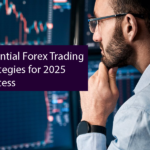
In the fast-paced world of forex trading, one element stands above all others in determining long-term success: risk management. While many traders focus primarily on entry signals, chart patterns, and technical indicators, the truly successful understand that preserving capital is what allows them to remain in the game long enough to profit.
Why Risk Management Is Your Most Important Trading Skill
The forex market can offer tremendous opportunities, but it also presents significant risks. Currency prices can move rapidly due to unexpected news, economic data releases, or shifts in market sentiment. Without proper risk management:
- A few bad trades can devastate your account
- Emotional decision-making often replaces rational analysis
- Recovery from major drawdowns becomes increasingly difficult
- Trading psychology deteriorates as losses mount
Professional traders often say that risk management isn’t just part of the trading plan—it is the trading plan. Everything else builds upon this foundation.
Essential Risk Management Principles for Forex Traders
Position Sizing: The Core of Risk Management
Perhaps no aspect of risk management is more critical than determining how much to risk on each trade. Experienced traders typically limit their risk to 1-2% of their total trading capital per position.
This conservative approach ensures that:
- A string of losses won’t significantly damage your account
- You can withstand normal market volatility
- Your emotions remain controlled during trading
- You maintain the capital necessary to take advantage of future opportunities
Systems like ForexWealthCode emphasize proper position sizing as a cornerstone of their methodology, helping traders avoid the common pitfall of overleveraging.
Stop-Loss Orders: Your Trading Insurance Policy
Stop-loss orders are non-negotiable components of effective risk management. These predetermined exit points:
- Limit potential losses on each trade
- Remove emotional decision-making during adverse moves
- Allow you to define risk before entering a position
- Provide clarity on risk-reward ratios
When placing stop-loss orders, consider:
- Technical levels that invalidate your trading thesis
- Average volatility of the currency pair
- Allowing enough room for normal market fluctuations
- Maintaining your predetermined risk percentage
The VIP Forex Wealth Code Masterclass provides detailed guidance on optimal stop-loss placement across different market conditions.
Risk-Reward Ratios: Making the Math Work in Your Favor
Successful trading isn’t about winning every trade—it’s about ensuring your winners are larger than your losers. This is where risk-reward ratios become crucial.
Most professional traders aim for risk-reward ratios of at least 1:2, meaning they expect to gain twice as much on winning trades as they risk on losing ones. With this approach:
- You can be right only 40% of the time and still be profitable
- The psychological pressure to be “right” diminishes
- You focus on high-quality setups with significant profit potential
- Your trading becomes sustainable over the long term
Correlation Risk: The Hidden Danger
Many traders unknowingly increase their risk by trading multiple currency pairs that move similarly. For example, simultaneously trading long positions in EUR/USD, GBP/USD, and AUD/USD effectively triples your exposure to USD weakness.
Managing correlation risk involves:
- Understanding which pairs tend to move together
- Diversifying across uncorrelated or negatively correlated pairs
- Reducing position size when trading correlated pairs
- Considering the “portfolio effect” of all open positions
The comprehensive approach found in ForexWealthCode helps traders recognize and manage these correlation risks effectively.
Leverage: A Double-Edged Sword
While forex trading offers significant leverage, using it excessively is a primary cause of trading failure. Leverage amplifies both profits and losses, and many traders focus only on the former while ignoring the latter.
Prudent leverage management includes:
- Using lower leverage than what’s maximally available
- Adjusting leverage based on market volatility
- Understanding that leverage doesn’t need to be fully utilized
- Focusing on consistent returns rather than outsized gains
Risk Management During Drawdowns
All trading systems experience periods of drawdown. How you manage these challenging periods often determines your ultimate success.
Effective drawdown management strategies include:
- Reducing position sizes temporarily
- Focusing on your highest-probability setups
- Reviewing but not abandoning your trading system
- Maintaining psychological resilience
Traders following the VIP Forex Wealth Code Masterclass receive specific guidance on navigating these inevitable challenging periods.
Implementing a Comprehensive Risk Management Framework
Creating a robust risk management framework involves several key steps:
1. Define Your Risk Tolerance
Every trader has a different risk tolerance based on their financial situation, personality, and trading goals. Understanding your personal threshold for risk helps you:
- Set appropriate position sizes
- Determine suitable stop-loss distances
- Select trading strategies that align with your comfort level
- Maintain emotional equilibrium during volatile periods
2. Create Written Risk Rules
Documenting your risk parameters prevents emotional decision-making during market stress:
- Maximum risk per trade (e.g., 1% of capital)
- Maximum open risk across all positions (e.g., 5% of capital)
- Criteria for adjusting position size based on setup quality
- Conditions for reducing exposure (e.g., after consecutive losses)
3. Use Technology to Enforce Discipline
Trading platforms offer various tools to help maintain risk discipline:
- Automatic position sizing calculators
- Hard and guaranteed stop-loss orders
- Maximum daily loss limits
- Risk analytics to monitor overall exposure
4. Develop a Drawdown Recovery Plan
Having a predetermined plan for handling drawdowns prevents panic decisions:
- Specific position size reductions at different drawdown levels
- Clear criteria for when to pause trading temporarily
- Process for analyzing and addressing underperformance
- Steps for gradually returning to normal position sizing
Systems like ForexWealthCode incorporate these elements into a coherent framework that traders can follow even during stressful market periods.
Common Risk Management Mistakes to Avoid
Even traders with good intentions often make critical risk management errors:
Moving Stop-Losses During Trades
Adjusting stop-losses to avoid taking a loss ultimately leads to larger losses and eroded discipline. Instead:
- Set your stop-loss based on technical levels and risk parameters
- Accept that some trades will hit stops as part of normal trading
- Only move stops to lock in profits, never to extend losses
- Remember that preserving capital is more important than being right
Averaging Down on Losing Positions
Adding to losing positions might seem logical but often compounds losses:
- It increases exposure to trades already proving unsuccessful
- It violates predetermined risk parameters
- It often stems from emotional rather than rational decision-making
- It can lead to catastrophic losses if the market continues moving against you
Inconsistent Risk Application
Many traders apply risk rules inconsistently, being conservative sometimes but aggressive when they feel confident:
- Maintain consistent risk percentages regardless of recent results
- Avoid the temptation to “make back” losses with larger positions
- Apply the same disciplined approach to all trading sessions
- Remember that overconfidence often precedes major losses
Ignoring Overall Exposure
Focusing solely on per-trade risk while ignoring cumulative exposure across positions:
- Calculate and monitor total portfolio risk across all open positions
- Consider correlation effects when determining overall exposure
- Reduce position sizes when holding multiple positions simultaneously
- Establish maximum overall risk limits and adhere to them strictly
The VIP Forex Wealth Code Masterclass provides tools and frameworks to help traders avoid these common pitfalls.
Building Risk Management Habits for Long-Term Success
Transforming risk management principles into ingrained habits requires consistent practice:
1. Pre-Trade Risk Assessment
Before every trade:
- Calculate precise position size based on stop placement and risk percentage
- Determine potential reward and ensure it meets minimum risk-reward criteria
- Consider correlation with existing positions
- Verify that total portfolio risk remains within limits
2. Regular Trading Review
Periodically review your trading with a focus on risk management:
- Analyze whether position sizes were appropriate
- Evaluate stop-loss placement effectiveness
- Assess overall risk exposure during different market conditions
- Identify patterns in trading that indicate risk management weaknesses
3. Continuous Risk Education
Stay informed about risk management developments:
- Study how professional traders and fund managers approach risk
- Learn about advanced risk metrics and their application
- Understand how different market conditions affect risk parameters
- Update your risk management approach as your trading evolves
Conclusion: Risk Management as a Competitive Advantage
In a market where many participants focus primarily on finding perfect entry signals, superior risk management provides a significant competitive advantage. The ability to preserve capital during challenging periods ensures you remain in the game long enough for profitable opportunities to materialize.
Systems like ForexWealthCode and the more comprehensive VIP Forex Wealth Code Masterclass emphasize this fundamental truth: successful trading begins with effective risk management. By making capital preservation your primary focus, you establish the foundation upon which all other trading skills can build.
Remember that in forex trading, it’s not just about how much you make during winning periods, but how well you protect your capital during inevitable drawdowns. Master risk management, and you’ve already overcome the greatest challenge most traders face.


